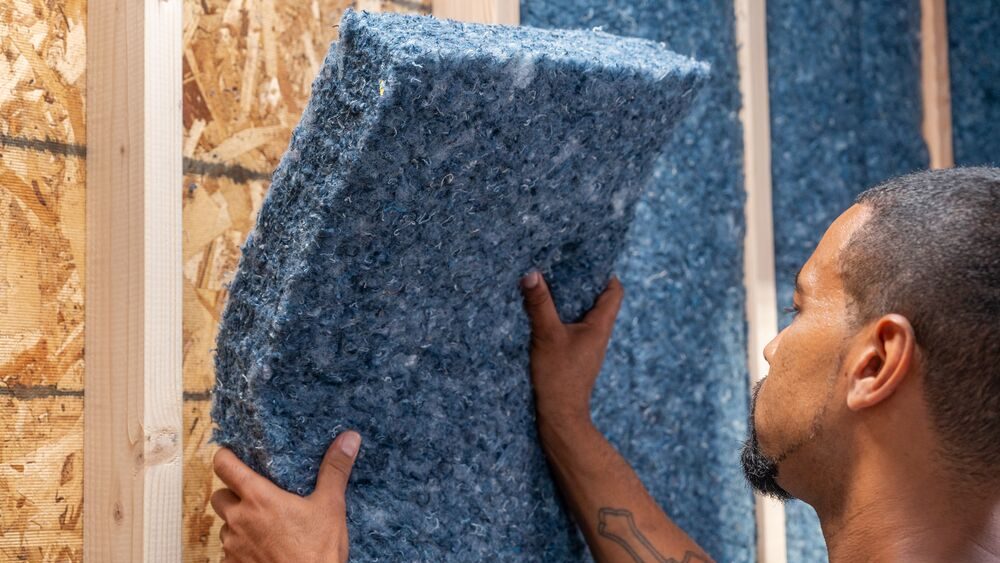Fiberglass is nearing a century as the predominant material for insulating interior walls, floors, and ceilings. As a cost-effective option with good thermal, acoustic, and fire-resistant properties, its popularity is understandable.
The material has always had its drawbacks, though. As a skin, eye, and respiratory irritant, fiberglass requires the use of gloves, long sleeves, goggles, and masks or respirators. But contractors are familiar with handling it, so they’re used to the steps needed to safely work with it. Until recently, its other advantages (and the lack of a readily obtainable alternative) outweighed the discomfort and inconvenience.
Mineral wool has been around even longer and is seen as the only premium option, with superior fire resistance and sound attenuation, but that performance boost came at a higher price. Mineral wool is heavier and more brittle than fiberglass, posing additional handling challenges and requiring protective gear to prevent skin and respiratory irritation. All this explains why it’s never been as commonly specified as fiberglass.
Enter a best-of-both-worlds alternative: recycled denim
With the importance of using eco-friendly products and making routine tasks easier and more efficient, the need for an alternative to fiberglass that’s more cost-effective than mineral wool has been growing. Recycled denim insulation is poised to become the solution to the other challenges posed by commonly used materials while providing the premium performance associated with mineral wool.
Environmental advantages of denim insulation
While fiberglass and mineral wool tend to contain a fair amount of recycled material, both materials require significant energy consumption during manufacturing due to the high-temperature processes needed to melt glass, rock, or slag. By contrast, the production of recycled denim insulation is significantly less carbon-intensive, resulting in a smaller environmental footprint. It also offers an unprecedented solution for keeping massive amounts of unsuitable denim jeans, such as those not suitable for donation or consignment, out of landfills.
Unlike materials like glass or slag, which have well-established reuse pathways in manufacturing, recycled denim typically has fewer recovery options. In 2018 the EPA estimated that only 13% of clothing textile waste is recycled, and landfills received 11.3 million tons of textiles. This was 7.7 percent of all municipal solid waste landfilled. Denim insulation not only repurposes a material with limited large-scale recovery infrastructure but gives it a long-term application that avoids the common fate of going into landfills.
The primary brand on the market, UltraTouch Recycled Denim Insulation, obtains jeans and cotton textiles through a partnership with Cotton Incorporated’s Blue Jeans Go Green initiative, which helps coordinate take-back programs through retail recycling programs like those at Madewell, Target, and Zappos. With more than 17 million tons of textiles generated annually, there’s no shortage of raw material to work with.
A tried-and-true insulation option
Denim insulation has long been a well-received consumer option, which has been improved and enhanced over the years into a high-performing alternative. UltraTouch’s dense cotton fiber insulation consistently achieves higher acoustic ratings than fiberglass. Like mineral wool, it is more effective at blocking and absorbing sound waves. Its thermal performance and resistance to fire, mold, mildew, and pests meet or exceed other insulation types.
The most significant improvement for workers handling the material is its respiratory safety and lack of irritants. Only denim made from at least 80% cotton is used to create UltraTouch. Since UltraTouch is made from recycled cotton denim and textile binder, the insulation is soft and won’t cause itching or respiratory problems if handled without PPE. It’s lighter-weight and more flexible than mineral wool, making it easy to manipulate and fit anywhere it’s needed. A midline perforation in the roll makes it easy to tear, and the cotton can be cut into any shape or size.
A single source for insulation needs
While denim insulation has been in existence for years, long enough to have proven performance, it’s typically sold in smaller quantities at home-improvement stores. It wasn’t until Carlisle Companies acquired UltraTouch in 2025 that it became abundantly available on a national scale.
As part of Henry, a Carlisle company, UltraTouch joins a comprehensive suite of insulation products that includes spray foam for attics as well as weather resistive air barriers for exterior sheathing. “For builders trying to deliver energy efficient homes, we enable them to source a complete building envelope system from a single supplier,” says Julie Eno, VP of Customer Insights at Carlisle. “That simplifies everything; you’ve got one team to support you from a technical perspective, with specifications and procurement, and with the warranty.”
Learn more about UltraTouch, and see how Henry integrated systems for building envelopes help builders get their jobs done easier while meeting performance and sustainability goals.
Research Sources:
Textiles: Material-Specific Data
Insulation makers tally recycled glass consumption
Recycled Content Use Tops 3 Billion Pounds
The History of Fiberglass Insulation
Fiberglass Insulation: History, Hazards and Alternatives
Denim Insulation Pros, Cons, R value
Denim Insulation Review: Comparison Guide and Pros and Cons
Recycled Denim Insulation: Turning Waste into Warmth
Textile Recycling Services in Minneapolis Minnesota


